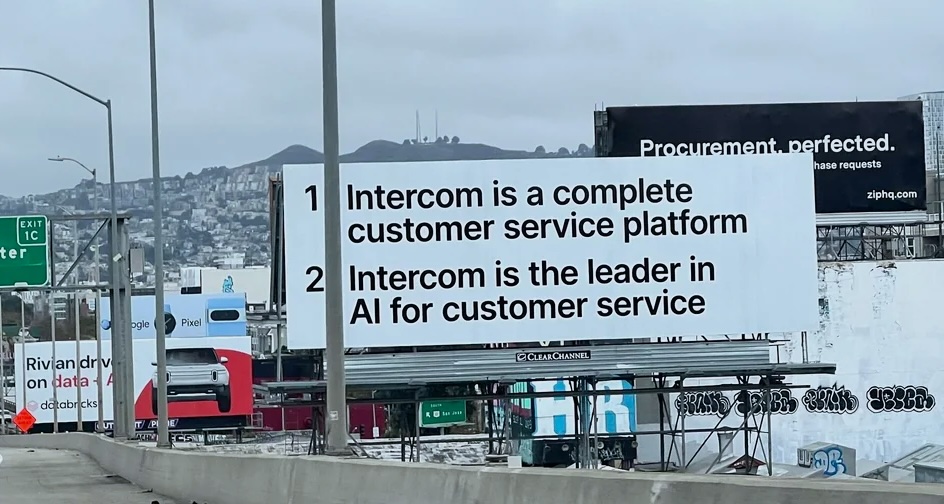If AI is so exciting, why is AI branding and marketing so boring?

Living in the Bay Area, it’s hard to avoid AI ads. Driving on Interstate-80 through San Francisco is a gauntlet of 40+ billboards in less than a mile—nearly every single one is about AI. Ads on YouTube are the digital equivalent. Salesforce, IBM, SAP, Meta, Google, Apple (all links to their AI offerings)—every one is very keen to share that they have AI. The budgets for AI branding, marketing, and advertising are clearly large. The messages, however, mostly don’t work.
These messages all fall into one of two categories:
Category one ads say “We’re smart because we harness AI. Buy our wares.”


Category two ads ask “What if your business had our super special AI magic sauce?”

This winds up feeling predictable, boring, and clearly undifferentiated. So why is this happening?
These ads and their underlying marketing approaches are suffering from being overly generic for three key reasons
- Because of the broad and multifaceted nature of AI. AI is capable of doing so much that it feels limiting to focus on any specific use case. It’s also capable of learning and, in many cases, being trained on specific data sets, so it can kind of do whatever a business needs it to. However, it can do whatever you want goes against the basic branding and marketing tenets of differentiation and specialization. Try to attract everyone and you end up attracting no one. For example, in gSuite, I’m constantly being prompted with essentially pop ups asking if I want to “ask Gemini” on whatever doc or spreadsheet or presentation I’m in. “Cool doc you got there, wanna go all AI on it?” This feels really clunky and not the best introduction to a new supposed supertool.
- Low but rising understanding of what AI can actually do. AI has a tremendous amount of hype. Many businesses get the sense they need it but don’t really understand how it can help them specifically. This leads to statements like “Business is better with [insert company] AI,” or “[company] AI is built to meet the growing needs of your business.” Who wouldn’t want their business to be better? This kind of messaging either doesn’t land or lands with people and companies who buy the hype without understanding, or needing to understand, what’s in the box. AI is a tool, a powerful tool, but it isn’t a panacea.
- Enormous investment in AI leads to overselling potential. It’s clear that the tech companies with significant branding and marketing budgets have dumped vast resources into developing their AI offerings. These investments need to pay dividends, preferably soon. If they don’t have specific areas where they are seeing strong traction it feels like they’re out fishing for whatever will bite.
The root cause here is youth of the technology. AI adoption is fairly new and we have seen this cycle before. With social media, companies realized they needed to be on it before there was any sort of template for how to interact or what to say. Earlier, companies realized they needed websites but had no idea what these websites should do or how they related to their core business. The way companies use AI will evolve and patterns will be established. Then the marketing and advertising will become more substantive as a result.

So what would work better?
Since everyone is saying they’re using AI, or rapidly figuring out how to say they do so, its utility as an attractor in branding and marketing is dropping.
The hype IS justified. AI obviously has tremendous potential. But, here’s the important part, TO DO WHAT? Show people the potential. Impress them. Do something interesting or appealing that couldn’t be done before. Give people enough of a taste so they can imagine what they could do with it. Be specific, build for and attract niche audiences.
What about just exploring and using AI without talking about AI at all? What if it’s just about the new skills you have, the things AI actually enables? Why does everyone need to know that AI was involved? Right now AI is perceived as this badge of being technologically current. How long will that be the case? I promise not for long.
This is less of a critique than a current state of affairs. We’re likely still very early in this era. It’s ok to be lost. Branding, marketing, and advertising exist to create differentiation and attract audiences. So as AI evolves, so will the way AI presents itself. it’s time to move past “AI inside.” It’s time to show, not tell.
If you want to see some of our AI naming and brand strategy case studies, check out HowSo, Imbue, and BrightBand, here.

